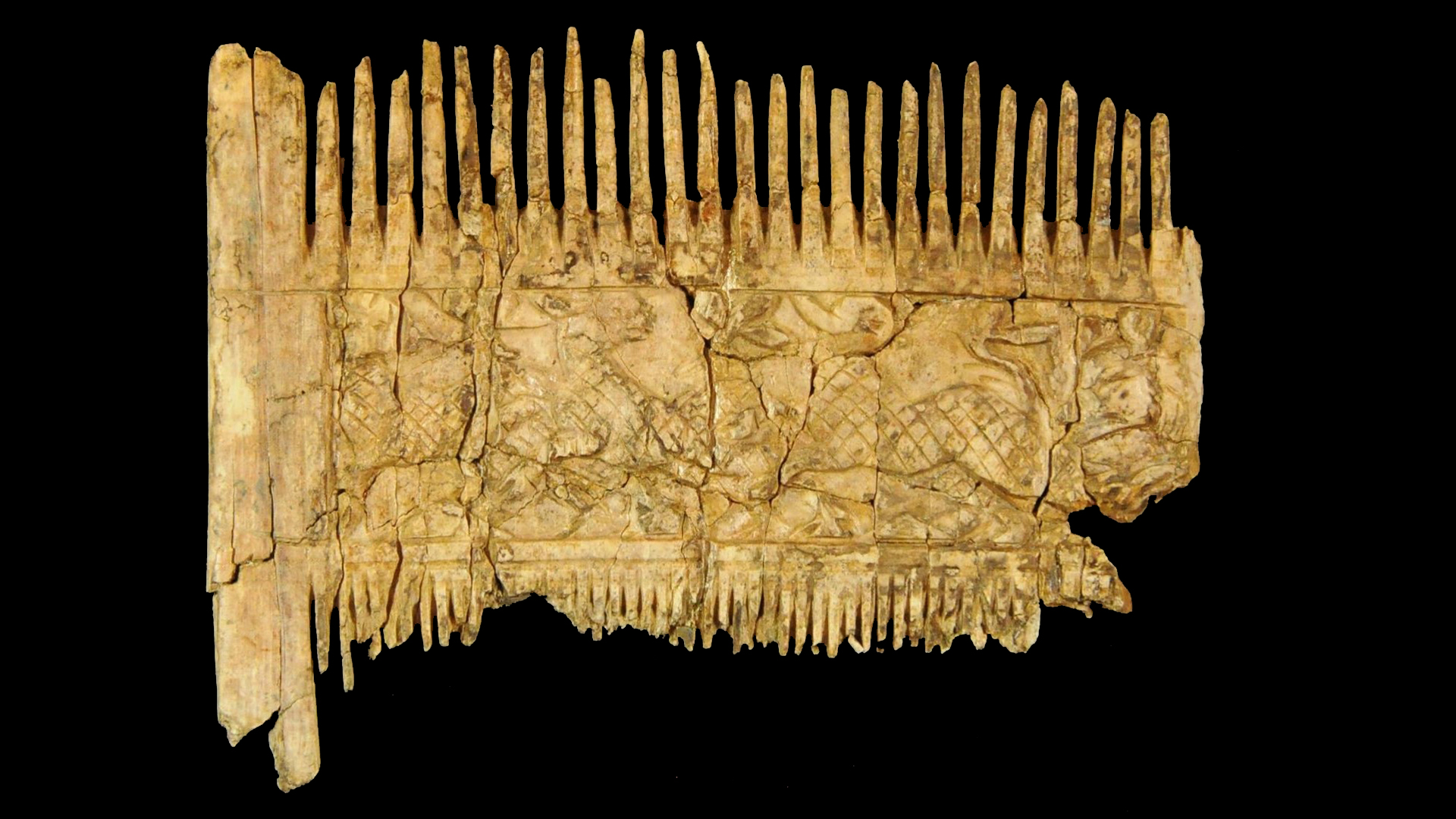Rich medieval hipster was buried with his fancy beard comb
Two graves in an ancient impact crater held luxury goods that were unusual for burials in the Middle Ages.

A wealthy medieval man who died over 1,500 years ago in what is now Bavaria, Germany, may have been a fierce warrior who also cared deeply about his personal appearance.
The man, who was about 40 to 50 years old when he died, was buried with fine weapons and a horse. But his grave also included luxurious toiletries, including a pair of scissors and an intricately carved ivory comb that may have been used to style his hair and beard, archaeologists recently reported.
They also discovered a second, equally lavish grave holding a woman who was about 30 to 40 years old when she died. It contained jewelry, food and a high-quality red ceramic bowl that likely came from northern Africa, representatives of the Bavarian State Office for Monument Protection (BLfD), the agency supervising the excavation, said in a German-language statement.
Related: Photos: Gold, amber and bronze treasures found in Iron Age grave
Both burials dated to around the sixth century A.D., according to the statement. The ivory comb and ceramic bowl were highly unusual burial items for this period, and they "must have been real luxury goods at the time," BLfD Conservator General Mathias Pfeil said in the statement (translated from German).
Scientists found the two graves in Bavaria's Nördlinger Ries, or Ries Crater. This ancient crater in southern Germany measures about 16 miles (26 kilometers) in diameter, with a rim that rises about 660 feet (200 meters) above the crater floor, according to NASA. It was identified in the 1960s as the site of a meteor impact, but because its subtle shape with low elevation blends into the surrounding landscape, the crater is not easily detected in satellite images, NASA reported.

Medieval Europeans may not have known that the area was once struck by a massive space rock, but they nonetheless followed the faint outline of its central depression to construct a settlement that covered 0.6 mile (1 km), according to NASA. Researchers discovered the two luxurious burials at the site of this ancient village, according to the BLfD.
Sign up for the Live Science daily newsletter now
Get the world’s most fascinating discoveries delivered straight to your inbox.
Gazelle-like animals
Restoration of the broken fine-toothed comb revealed carved decorations of animals on both sides of the object. In the scenes, creatures resembling gazelles leap to escape predators, though the scientists haven't yet confirmed the types of animals shown, according to the statement.
Combs are often found in graves from the Middle Ages, but they are usually simpler tools that aren't made of such fine material. Ivory carvings are rare in sixth-century burials, and very few ornately carved ivory combs are known from this period at all; the previously described combs from this period are all carved with Christian motifs rather than hunting scenes, the statement said.
Near the man's skeleton lay the remains of a horse, along with spurs and pieces of a bridle. There were also weapons in the grave, including a battle ax, lance, shield and longsword, hinting that their owner was wealthy and important, BLfD representatives said.

In the woman's grave were food items, such as preserved eggs, as well as a weaving sword, which is a wooden loom accessory used for tightening threads, according to the statement. But the standout item in her burial was the red bowl, which was in excellent condition. Unlike other vessels in the two graves, the bowl was not produced locally; rather, it was a style known from Mediterranean trade, and it likely originated in what is now Tunisia, in North Africa.
A cross was stamped into the bowl's base, and markings carved into the bowl's rim could be magical symbols or runes — letters in ancient Germanic alphabets — perhaps indicating the name of the vessel's owner, according to the statement.
However, further analysis is required to determine what the inscription might mean, BLfD representatives said.
Originally published on Live Science.

Mindy Weisberger is an editor at Scholastic and a former Live Science channel editor and senior writer. She has reported on general science, covering climate change, paleontology, biology and space. Mindy studied film at Columbia University; prior to Live Science she produced, wrote and directed media for the American Museum of Natural History in New York City. Her videos about dinosaurs, astrophysics, biodiversity and evolution appear in museums and science centers worldwide, earning awards such as the CINE Golden Eagle and the Communicator Award of Excellence. Her writing has also appeared in Scientific American, The Washington Post and How It Works Magazine. Her book "Rise of the Zombie Bugs: The Surprising Science of Parasitic Mind Control" will be published in spring 2025 by Johns Hopkins University Press.









